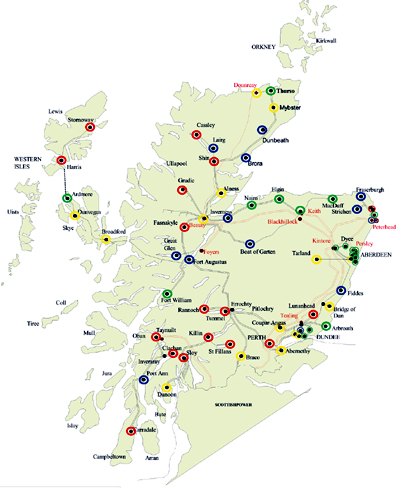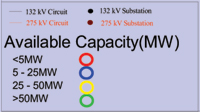


| Grid Connection |
The issues Offshore connection The future References
The issues
One major concern for industry and Government is the capacity of the grid to integrate new renewable generation, and the financing of any improvements required.


When the UK transmission and distribution system was developed, the intention was to generate output from large power stations (mainly coal, oil and gas fired), transmit this to demand centres, and then distribute it to local users. This flow of electricity was from a strong central point to a weaker periphery.
As a result, large-scale grid-connected marine current power generation encounters some problems. The site of marine current generation is dictated by the best location for the resource (i.e. the Pentland Firth, Shetland and Orkney). The majority of these sites are far from the centres of demand (i.e. the Midlands and South-East England), often with only a weak distribution network available - if any. Linking electricity generation in these areas to the local network can result in network problems and require costly reinforcement. For example, the 500kW wave device in Islay is able only to send 150kW to the local network due to the weak grid.
For full exploitation of the marine resource in Scotland, considerable improvements of the grid infrastructure are necessary, such as 400kV transmission lines on the north and western coasts. Some sub sea cables to islands may also be required.
The intermittent nature of renewable supply, even if this is predictable, causes the problem of fluctuating voltages on the grid.
back to top
Offshore connection
There will be two stages to marine current energy transmission:
- From the offshore device to the coast.
- From the coast to the main demand centres.
back to top
The future
The Scottish Executive, transmission owners and the DTI are addressing grid connection issues. Transmission companies have begun planning work to allow at least a further 2GW of renewable generation to be connected to the grid in Scotland. This includes thermal studies, coltage compliance and stability studies and cost benefit analyses.
When electricity is transmitted on the national grid system over long distances, losses are incurred. Where the grid system is operating efficiently, the losses are low but there are some variations. Currently the cost of these losses results in an average transmission-loss charge on generators - including renewables. Ofgem, the market regulator, is proposing that the average charge is replaced by a locational measure to reflects the higher loss levels with the increasing distance to demand. As a result, all the generators within an area would be charged at a rate accounting for the zonal losses of that location. This has major cost implications for the siting of renewable generation in Scotland. It will become preferential to locate all new generation plant in the south-east of the UK, closest to demand, where the zonal charge will be lowest. This will adversely impact marine current technology in Scotland as the location of the resource offshore from the north west coast is a long way from the Scottish and UK centres of demand.
It is likely that the push for windpower will help to overcome many of the transmission barriers facing marine current power. However, considering the valuable resource that may still be uneconomic to exploit due to its remoteness, there is also the future possibility of using offshore energy generation to produce hydrogen by electrolysis, which could be collected by boat at regular periods. Seapower are addressing this possibility in their designs, anticipating an increased demand for hydrogen as it becomes a widespread fuel as part of the ‘hydrogen economy’.
back to top
References
- S P Transmission, Scottish & Southern Energy plc, National Grid (2003), Distribution and Renewable Energy Transmission Study.
- S P Transmission & Distribution, Scottish & Southern Energy plc (2001), Impact or Renewable Generation on the Electrical Transmission Network in Scotland, Scottish Executive Renewable Energy Network Study Group.